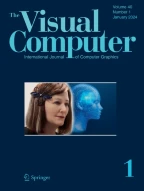Abstract
We present a simplification algorithm for manifold polygonal meshes of plane-dominant models. Models of this type are likely to appear in man-made environments. While traditional simplification algorithms focus on generality and smooth meshes, the approach presented here considers a specific class of man-made models. By detecting and classifying edge loops on the mesh and providing a guided series of binary mesh partitions, our approach generates a series of simplified models, each of which better respects the semantics of these kinds of models than conventional approaches do. A guiding principle is to eliminate simplifications that do not make sense in constructed environments. This, coupled with the concept of “punctuated simplification”, leads to an approach that is both efficient and delivers high visual quality. Comparative results are given.
Similar content being viewed by others
Explore related subjects
Discover the latest articles, news and stories from top researchers in related subjects.References
Botsch, M., Steinberg, S., Bischoff, S., Kobbelt, L.: OpenMesh – a generic and efficient polygon mesh data structure. OpenSG Symposium (2002)
Cohen, J., Olano, M., Manocha, D.: Appearance-preserving simplification of polygonal models. In: Proceedings ACM SIGGRAPH’98, pp. 115–122 (1998)
Coors, V.: Feature-preserving simplification in web-based 3D-GIS. First International Symposium on Smart Graphics, New York (2001)
de Berg, M., Van Kreveld, M., Overmars, M., Schwarzkopf, O.: Computational Geometry. Springer, Berlin Heidelberg New York (2000)
De Floriani, L.: Feature extraction from boundary models of three-dimensional objects. IEEE Trans Pattern Anal Mach Intell 11(8): 785–798 (1989)
El-Sana, J., Varshney, A.: Topology simplification for polygonal virtual environments. IEEE Trans Visual Comput Graph 4(2):133–144 (1998)
Erikson, C., Manocha, D., Baxter III, W.V.: HLODs for faster display of large static and dynamic environments. In: Proceedings ACM Symposium on Interactive 3D Graphics, pp. 111–120 (2001)
Früh, C., Zakhor, A.: 3D model generation for cities using aerial photographs and ground level laser scans. In: Proceedings IEEE Computer Vision and Pattern Recognition, pp. 31–38 (2001)
Garland, M., Heckbert, P.: Surface simplification using quadric error metrics. In: Proceedings ACM SIGGRAPH ’97, pp. 209–216 (1997)
Garland, M., Heckbert, P.: Simplifying surfaces with color and texture using quadric error metrics. In: Proceedings IEEE Visualization’98, pp. 263–269 (1998)
Gavankar, P., Henderson, M.R.: Graph-based extraction of protrusions and depressions from boundary representations. Comput Aided Des 22(7):442–450 (1990)
Hoppe, H.: Progressive meshes. In: Proceedings ACM SIGGRAPH’96, pp. 99–108 (1996)
Hoppe, H.: View-dependent refinement of progressive meshes. In: Proceedings ACM SIGGRAPH’97, pp. 189–198 (1997)
Jang, J., Ribarsky, W., Shaw, C., Wonka, P.: Appearance-preserving view-dependent visualization. In: Proceedings IEEE Visualization, pp. 473–480 (2003)
Jepson, W., Liggett, R., Friedman, S.: Virtual modeling of urban environments. Presence 5(1):72–86 (1996)
Kho, Y., Garland, M.: User-guided simplification. In: Proceedings ACM Symposium on Interactive 3D graphics, pp. 123–126 (2003)
Kim, Y.S.: Recognition of form features using convex decomposition. Comput Aided Des 24(9):461–476 (1992)
Lindstrom, P., Koller, D., Ribarsky, W., Hodges, L.F., Faust, N., Turner, G.A.: Real-time, continuous level of detail rendering of height fields. In: Proceedings ACM SIGGRAPH’96, pp. 109–118 (1996)
Lindstrom, P., Turk, G.: Fast and memory efficient polygonal simplification. In: Proceedings IEEE Visualization’98, pp. 279–286
Low, K.L., Tan, T.S.: Model simplification using vertex clustering. In: Proceedings ACM Symposium on Interactive 3D Graphics, pp. 75–82 (1997)
Lu, Y., Gadh, R., Tautges, T.J.: Feature decomposition for hexahedral meshing. In: Proceedings ASME Ddesign Automation Conference (1999)
Lu, Y., Gadh, R., Tautges, T.: Volume decomposition and feature recognition for hexahedral mesh generation. 8th International Meshing Roundtable, SAND99-2288, Sandia National Laboratories, pp. 269–280 (1999)
Luebke, D.: A developer’s survey of polygonal simplification algorithms. IEEE Comput Graph Appl 21(3):24–35 (2001)
Marefat, M., Kashyap, R.L.: Geometric reasoning for recognition of three-dimensional object features. IEEE Trans Pattern Anal Mach Intell 12(10):949–965 (1990)
Maya® version 6.0, April 9 (2004)
Parish, Y., Mueller, P.: Procedural modeling of cities. In: Proceedings ACM SIGGRAPH 2001, pp. 301–308 (2001)
Pojar, E., Schmalstieg, D.: User-controlled creation of multiresoltion meshes. In: Proceedings ACM Symposium on Interactive 3D Graphics, pp. 127–130 (2003)
Pratt, M., Wilson, P.R.: Requirements for support of form features in a solid modeling system. Technical Report R-85-ASPP-01, CAM-I Inc, Arlington Texas, June (1985)
Ribelles, J., Heckbert, P., Garland, M., Stahovich, T., Srivastava, V.: Finding and removing features from polyhedra. In: Proceedings ASME Design Engineering Technical Conference, September (2001)
Rossignac, J., Borrel, P.: Multi-resolution 3D approximations for rendering complex scenes. In: Geometric Modeling in Computer Graphics, pp. 455–465, Springer (1993)
The Stanford 3D Scanning Repository. http://graphics.stanford.edu/data/3Dscanrep/ (2004)
Williams, N., Luebke, D., Cohen, J., Kelley, M., Schubert, B.: Perceptually guided simplification of lit, textured meshes. In Proceedings ACM Symposium on Interactive 3D Graphics, pp. 113–121 (2003)
Wonka, P., Wimmer, M., Sillion, F., Ribarsky, W.: Instant architecture. In: Proceedings ACM SIGGRAPH 2003, pp. 669–678 (2003)
Woo, T.: Feature extraction by volume decomposition. In: Proceedings Conference CAD/CAM Technology in Mechanical Engineering, MIT (1982)
Wu, M.C., Liu, C.R.: Analysis on machined feature recognition techniques based on B-rep. Comput Aided Des 28(8):603–616 (1996)
Author information
Authors and Affiliations
Corresponding author
Rights and permissions
About this article
Cite this article
Jang, J., Wonka, P., Ribarsky, W. et al. Punctuated simplification of man-made objects. Visual Comput 22, 136–145 (2006). https://doi.org/10.1007/s00371-005-0355-6
Published:
Issue Date:
DOI: https://doi.org/10.1007/s00371-005-0355-6
